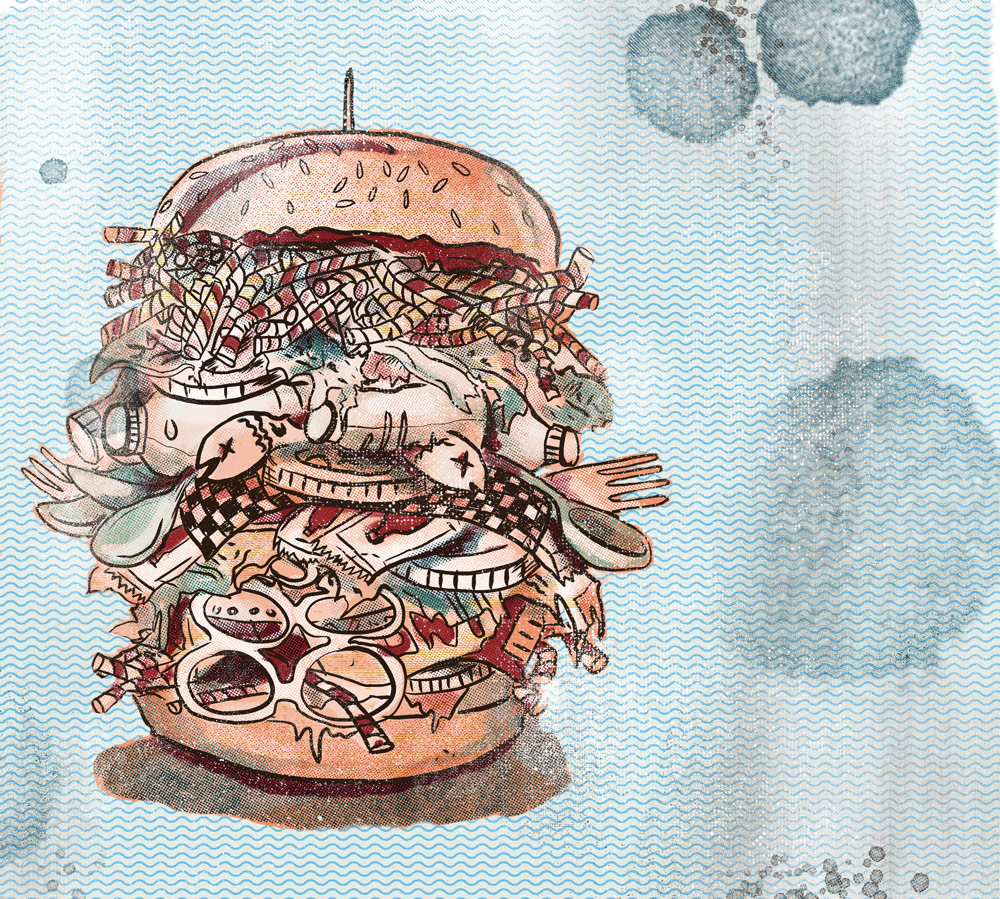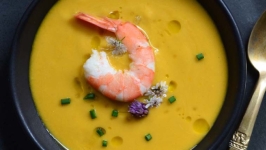Sweet Jesus, What Do We Do With All This Plastic?
The spoon my eight-month-old son uses every morning to eat his breakfast is hardly what you would call a keepsake. Next to the delicate baby spoons hidden away in his great-grandmother’s hand-carved chest of silverware, this spoon is absolutely worthless — except it will never tarnish. Like most kids’ cutlery, it’s made of plastic. Its playful aquamarine hue is often caked with mushy peas and God knows what else. Its long handle is embossed with the words “Sweet Jesus” — the name of the hyperstylized, boisterously branded (and extremely effective) soft-serve ice cream chain. It is the same spoon that comes with every dish of ice cream they sell. The same spoon you’re expected to use once and toss.
I've had this spoon for at least a year, after an all-consuming craving late last summer during the final stretch of pregnancy sent me waddling downtown in search of ice cream. I could have easily brought a spoon with me — I have countless more, along with an increasing amount of plastic odds and sods stashed in my car and kitchen. But what’s a culture of consumptive convenience if you are actually expected to remember to bring your utensils with you?
So, into my cringeworthy collection it went, where I will one day have to face the horror of throwing it away. Perhaps, I am a bit of a hoarder — I definitely fit the profile of feeling conflict and consternation under the weight of all this useless junk. But, let’s be honest, where is it going to go? Of all of the 83 trillion tons (and counting) of plastic we've created since the 1950s, nearly all of it is still kicking around somewhere, adrift in polymer purgatory. We’ve already ditched about 63 trillion tons and most of that has wound up in a landfill. Perhaps, the best case scenario is that it will live out its pseudo-immortal days buried in a mountain of plastic until it returns to a primordial state.
But it is just as likely to wind up in the ocean, where roughly 8 million metric tons of waste is dumped annually — the equivalent of 22,000 plastic-laden 747s nose-diving into the water each year. By the time my son reaches his 13th birthday, our oceans will be well on their way to being mostly plastic as the accumulation of synthetic polymers is expected to outweigh fish, pound for pound, by 2050. Most of this will be in the form of micro-plastics — the tiny particles that shed off our water bottles and stir-sticks, and fibres that are sent teeming down the drain and out to sea with every wash of our cheap, semi-disposable clothing.
But the rest will be the plastic junk that encases our food and drink, as 70 per cent of all plastics are destined for packaging. The top 10 items found during the 2016 International Coastal Cleanup, an initiative of the Ocean Conservancy, were primarily food items: more than 18 million pounds of bags, containers, cutlery, straws, bottles and bottle caps were collected off of the coastlines of more than 112 countries (the noteworthy exception to that rule was cigarette butts, which took the No. 1 spot by a landslide). Whatever adorable (and not so adorable) sea life manages to avoid snorting a straw, choking on a cigarette butt or finding itself grotesquely corseted by a beer ring, will still wind up eating the stuff on a micro-scale and so will we.
It’s enough to make you feel choked up. Not quite as choked up as, say, a young pilot whale off the coast of Thailand that was found with five grocery bags in its gullet (and a further 80 in its belly) earlier this year. Or the sea turtle that sent a tidal wave through the plastics industry, after it was found with a four-inch straw lodged inside its nasal passage, probably thinking it was a snack, swallowed it and then regurgitated it out the wrong canal. The video, captured by a team of marine biologists near Costa Rica, was uploaded to YouTube in 2015. Millions have now witnessed the unfortunate reptile undergo an emergency straw-removal at sea and have now pledged to end their plastic-sucking habits. Even the Queen has had enough; her royal palaces are now under a single-use plastic ban after she spent time working on the Planet Earth series with the knighted naturalist, David Attenborough, who has undoubtedly witnessed an obscene amount of human filth in the farthest reaches of his beloved natural world.
To be honest, I thought we would have solved our plastic problem by now. Growing up in the ’80s and early ’90s, I witnessed the growing list of planetary problems: Fish were flash-frying in the Great Lakes; old growth trees were being razed to the ground in B.C.; and we were unleashing invisible compounds called CFCs into the upper atmosphere where they gnawed at our ozone layer, threatening to burn us all to a crisp long before those pesky greenhouse gases cooked us from the inside out.
And then there was the garbage. In spite of the other ails, curbing some of our curb-side habits seemed, to me, child’s play. “We need recycling bins,” I wrote as an incensed 11-year-old in an essay to my local city council. The places I frequented — malls, public pools and parks — were bereft of bins, which had only recently been introduced to our regular roadside pickup. At the time, metals and paper made up the bulk of our reclaimable refuse, but plastics had quickly become a conspicuous pollution problem — and we needed somewhere to ditch them.
My essay landed me the top prize — I got to be “mayor for a day.” All this really meant was that I got to ditch school and enjoy a painfully awkward lunch with the actual mayor. He talked to me about garbage while I picked at a plate of chicken fingers and fries and spent the rest of the day spinning around in his desk chair. Reporters from the local newspapers showed up and handed me his letter opener to twirl for the cameras and I left wondering if my pleas for less pollution had really been heard.
The next time I had my picture in the paper, it was almost 30 years later, when I was running my own restaurant. In a way, it didn’t feel all that different — I still tried to keep my unkempt bangs from falling in my eyes, as I had for the mayor’s cornball PR team — and I still felt as though the bigger picture was being overlooked. While an endless parade of foodies fawned over fork-to-pie placement and the overall Instagramabilty of eggs Florentine, I wondered if anyone cared about the amount of plastic waste their eating habits were generating.
Nevertheless, finally with a bit of real power, I tried my best to set things up so they wouldn’t have to give it much thought, at least when it came to take-out. Biodegradable boxes, recycled cups and lids, paper straws and I even managed to source cutlery that was made from birch. Needless to say, it was less than perfect — the fork tins were basically widdled down toothpicks and useless for eating much of anything (except mushy peas) and the paper straws eventually disintegrated in the root beer floats. I held steadfast and expected others to do the same.
But who was I kidding? Even now, as the war against the plastic straw picks up steam and people again embrace the paper straw for as long as it stays erect, I fear it might be too little, too late. From sip to source, plastic has infected the entire food supply chain. Even the most local, fresh-off-the-farm produce often comes from “plasticulture,” where agrarian landscapes are literally layered in plastics — greenhouse coverings, irrigation tubing and potting trays. In restaurants, where Cling Wrap is about as indispensable as a sharp knife, recycling has remained as novel as it was in the '80s. (Not that the third “R” has been much of a success story — even with all our efforts we’ve only managed to capture and recycle a measly 9 per cent of all plastics, leaving the ensuing tsunami of plastic flotsam and jetsam with little to abate its path.)
When a regular pointed out that David Suzuki was standing across the street, I left my restaurant unmanned and ran right over. I didn’t know what to say, so I gave him a hug. In hindsight, I should have dragged him back across the street and demanded answers. Maybe he would have had some or maybe he would have just taken a picture of a Dagwood sandwich with his phone — at least the triple-decker clubhouse had a bamboo toothpick keeping it all together.
Since my son was born, I find I am constantly decluttering, which has me ditching a lot of plastic into the void. All I can hope is that, in another 30 years, when Suzuki has been recycled back into the nature of things, that the tides will have turned and another generation won’t be left to deal with all the plastic left in our wake. For now, my son and I just watch the spoon as I shovel another mouthful of nebulous mook into his mouth. Then it dawns on me — he’ll also be dead and gone, while his Sweet Jesus spoon lives on.





